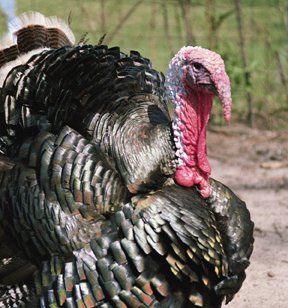Fowl News—Food Additive’s Extra Benefit
A food additive that keeps crackers, cereals, and other foods fresh could one day be prescribed to domesticated turkeys. And if it protects people from the effects of a class of common foodborne poisons as well as it does the birds, the additive might be touted on food labels as a cancer fighter.

The additive is BHT (for butylated hydroxytoluene), and the food contaminants are aflatoxins, carcinogenic substances from fungi. Roger Coulombe Jr. and his colleagues at Utah State University have shown that food laced with BHT almost eliminates aflatoxin poisoning in turkeys, animals that are substantially more sensitive to such effects than people are.
Although farmers haven’t yet won the Food and Drug Administration’s approval to add BHT to turkey chow, Coulombe, a veterinary toxicologist, says that the food additive shows great promise. BHT is already on the FDA’s list of chemicals that are “generally regarded as safe” in food.
This month, at the Society of Toxicology annual meeting, in New Orleans, Coulombe and John A. Guarisco reported progress in understanding how BHT fights the effects of aflatoxins. Their data suggest that as BHT protects turkeys’ DNA from damage, it could do the same in people. The primary risk to a person from chronic aflatoxin exposure is liver cancer.
Because DNA damage often presages cancer, the researchers argue that the additive or some related chemical might eventually warrant incorporation in the human food supply as a health-promoting nutraceutical (see The Rise of Nutraceuticals).
Turkeys as canaries
As coal miners a half-century ago learned that caged canaries taken underground can signal danger because of their sensitivity to deadly gases, biologists long ago discovered that turkeys are exceptionally vulnerable to aflatoxins.
In 1960, more than 100,000 young turkeys died rapidly in Britain from a mysterious new illness tentatively called turkey X disease. Eventually, the cause was traced to contamination of Brazilian peanut meal with Aspergillus fungi, which produce aflatoxins. Some toxicologists now credit this epidemic for jumpstarting the field of mycotoxicology, the science of fungal poisons.
Aflatoxins refer to some 10 related Aspergillus poisons. Spores of the fungi taint peanuts, corn, milk, and many stored grains. Toxin contamination can easily skyrocket in moist conditions, which favor the fungi’s growth.
Just 50 parts per billion of an aflatoxin in feed—a little more than double the amount that FDA permits in human foods—can stunt the growth of turkeys, weaken them, and trigger immune problems. Over the past decade, veterinary researchers have been searching for why these birds are so vulnerable to aflatoxins.
The Utah State team identified a double whammy: Not only are the animals’ bodies unusually effective at activating the toxins, but they also are remarkably ineffective at converting these activated toxins into a form that can be excreted.
DNA impacts
Chemically, BHT is an antioxidant. That means that in foods, it can quash the chemical reactions that turn oils rancid or induce other off flavors. Because past research in laboratory animals suggested that at least one class of antioxidants could prevent some chemically induced diseases, Coulombe’s team decided to see whether BHT—a potent member of that class—might confer some protection against what Aspergillus can do.
Three years ago, the Utah State researchers showed that BHT indeed “counteracts many of the deleterious effects caused by aflatoxin,” ranging from poor weight gain to liver damage in turkeys.
In New Orleans, Guarisco and Coulombe reported that activation of the primary Aspergillus poisons—aflatoxin B1 and aflatoxin B2—can foster their inappropriate binding to DNA, a first step in many cancers.
When the researchers put BHT in test tubes containing aflatoxins with pieces of the liver cells that ordinarily make aflatoxin-activating enzymes, BHT inhibited the enzymes’ action by 40 to 50 percent.
Then, the researchers and their colleagues tested a BHT-laced diet in young turkeys. The scientists raised turkey hatchlings on a standard diet for 10 days and then switched half of the birds to BHT-supplemented food for another 10 days. On the 21st day, Guarisco says, all the animals received a dose of aflatoxin B1 that should make the turkeys sick, but not kill them.
Over the following 2 days, the toxicologists examined the animals’ blood, liver, muscles, and other tissues. Their data show that turkeys eating BHT-treated meals contained less aflatoxin B1 in their blood than did birds eating untreated feed.
More importantly, birds eating BHT-laced feed experienced virtually no illness, while birds getting the untreated feed became slightly ill, growing 40 percent less than the BHT-fed birds did. This suggests, the Utah State scientists conclude, that farmers might want to routinely supplement turkey feed with such an additive.
Moreover, Guarisco finds, the BHT concentrations needed to prevent aflatoxin poisoning didn’t accumulate in edible turkey tissues enough to exceed the limit FDA has set for human food.
Possible anticancer benefit
The same aflatoxin-induced changes that make turkeys sick might ultimately lead to cancer, Coulombe says, if they lived long enough. However, in the farmed birds, cancer is never an issue because most are slaughtered at just 17 weeks of age.
Still, in some ways these studies serve “as a model for human carcinogenesis,” he told Science News Online, because the enzymes that activate aflatoxin in people are quite similar to those turned on in turkeys. That’s why other Utah State researchers are now assessing the ability of BHT to inactivate human enzymes.
“It wouldn’t be a stretch” to predict that BHT will protect people, Coulombe says. However, he also suspects that some other chemical might be better for the human food supply. At this point, he says, “we prefer to think of [BHT’s] use as a proof of concept.”







